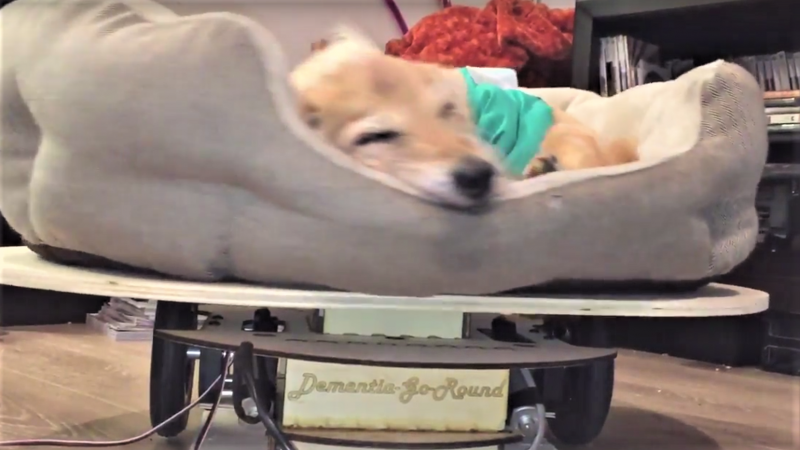When [Jason Dorie] tipped us off on this, he said, “This barely qualifies as a hack.” We disagree, as would any other dog lover who sees how it improved the life of his dog with a simple mood-altering doggie-bed carousel.
[Jason]’s hack lies not so much in the rotating dog bed – it’s just a plywood platform on a bearing powered by a couple of Arlo robot wheels. The hack is more in figuring out what the dog needs. You see, [Thurber] is an old dog, and like many best friends who live a long life, he started showing behavioral changes, including endlessly pacing out the same circular path to the point of exhaustion. Circling in old dogs is often a symptom of canine cognitive dysfunction, which is basically the dog version of Alzheimer’s. Reasoning that the spinning itself was soothing, [Jason] manually turned [Thurber]’s dog bed on the floor. [Thurber] calmed down immediately, so the bittersweetly named “Dementia-Go-Round” was built.
Sadly, [Thurber] was actually suffering from a brain tumor, but he still really enjoyed the spinning and it gave him some peace during his last few days. Looking for hacks to help with human dementia? We’ve had plenty of those before too.

















Sure it’s a hack – and a well done, too. If hacking can give a beloved one, two-, three or four-legged, some comfort, hack away!
:)
Great thinking!
this is a great hack.
thanks for sharing.
And sorry for your loss.
Damn article made me tear-up. Most all of us have lost a ‘best friend’ at some point.
Cute doggo, great hack.
My dog is old, but hasn’t started pacing. However, she’s afraid of anything even remotely mechanical, including guitars, pots and pans, cardboard boxes… This would be “Nope nope nope”
Needs to be tagged with ninja cutting onion warning. Quality of life hack gave that poor dog a peaceful last days
“This barely qualifies as a hack.”
Force “not a meme” to be a meme.
Some old humans have the same problem too, I think he may be onto something bigger than he realises. I showed the video to somebody with expertise in the area and they agreed, the concept is brilliant.
I agree it may well be getting at something deeper. Or it may be one of those one-off “brain tumors are friggin weird” things. I’ve read about all kinds of motor issues, and even cases of a person’s personality abruptly changing,
Nicely done… and it’s good to know it gave his pooch some comfort in his final days.
Just don’t spin it too fast, the end result might be a tad messy.
The feels man….
Awesome that you got to do this for your best bud in his last few days.
Oww, my feels!
Right in the feel!
Feel Of The Week!
Might need to build this for my parent’s dog… She’s 16 years old and paces a lot, especially at night when nobody is awake to calm her down. I’m sure she’d appreciate it a lot.
14/10 excellent puppers
Dan you need to put warnings on articles like this…
OMG, so much feel. It reminded me of my old dog who had tumor. Kudos to you my friend for going the extra mile for your best pal. Karma point
Thanks everyone – It was such a rewarding thing to see. He only got to use it for a few days, but it made such a difference for him it made me sad that we hadn’t thought of it sooner. It’d be awesome if it could help someone else.
Also, if you want an extra good cry, Sara wrote about her life with Thurber, and talks about the various things we made for him over the years, including the Thurber Feeder 5000, a co-sleeper bed, a crib, and finally the bed spinner. Comes with the requisite onion-cutting warning:
https://psiloveyou.xyz/the-life-and-times-of-thurber-james-michener-1689b803b8ed
Dammit, Jason. Too many ninjas, too many onions. What a beautiful piece of writing about a beautiful family. Thank you for sharing it with us!
One of my cats walks in circles a lot. He’s blind, and also has cerebellar hypoplasia, which is a sort of brain defect that often leads to motor dysfunction. (We got the cats a few months ago when they were 7; the blindness was from an infection when he was a kitten.) He circles more when he’s stressed or feels lost, but also sometimes just when he doesn’t have anything better to do, and we think that’s probably CH-related. Distracting him helps. One of his adaptations to blindness is that he keeps his claws out most of the time, so they click when he’s walking on wood floors. His brother has a bit of the head shakiness, so he may have a mild case of CH also, but doesn’t do the circling bit.
Oh, also he’s a bit extra-loud because he’s polydactyl – in his case it’s extra thumbs in front, rather than extra middle toes which is more common, and the extra thumbnails seem to be larger. (I’m told that polydactyly is part of a plan by cats to develop opposable thumbs, and once they get it working they won’t need to depend on apes to do things for them.)